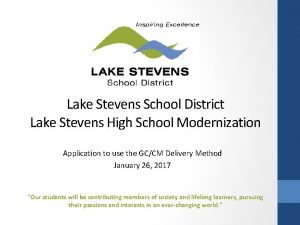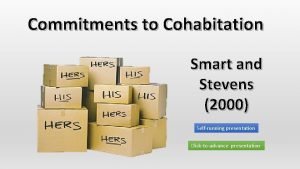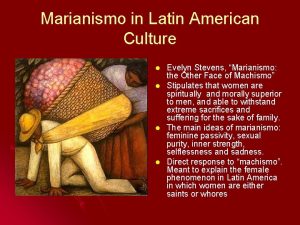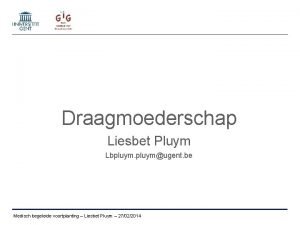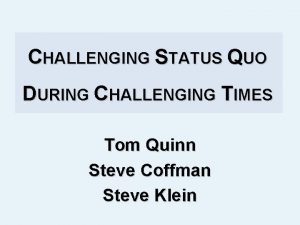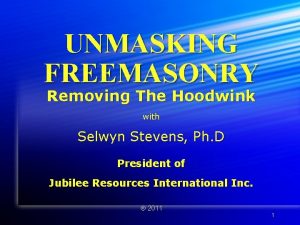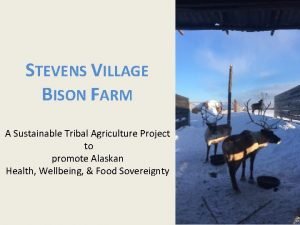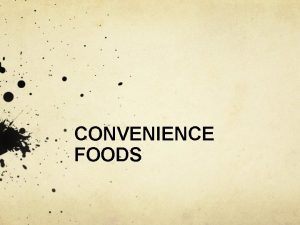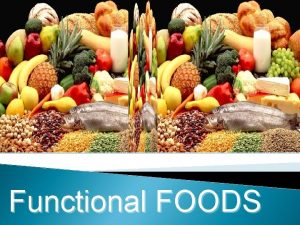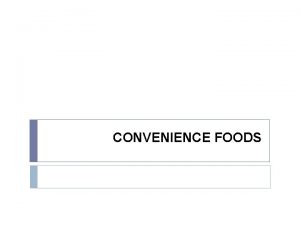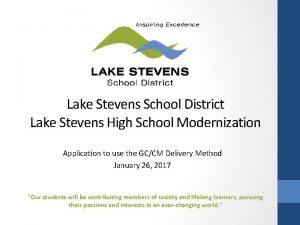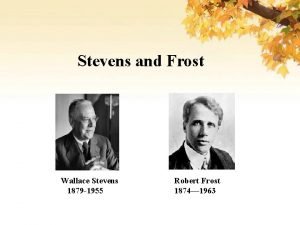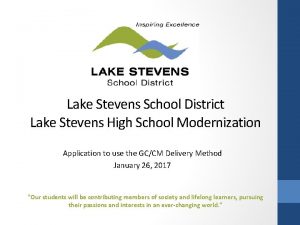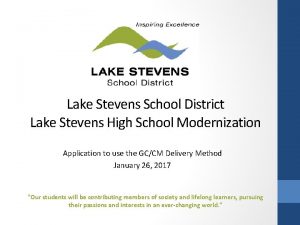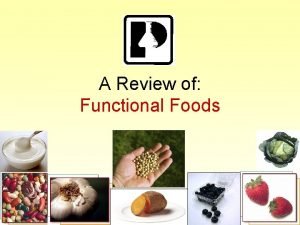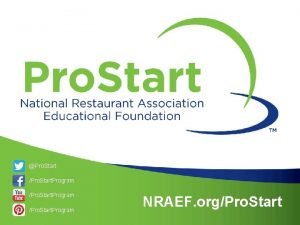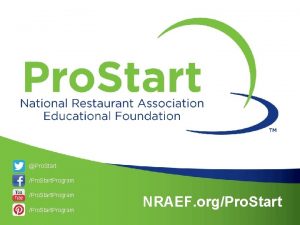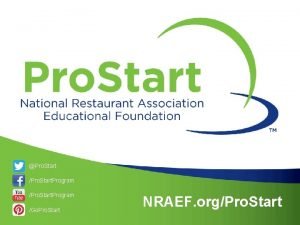Foods Review Foods 2 Ms Stevens Start RecipeHow

















- Slides: 17

Foods Review Foods 2 Ms. Stevens

ØStart Recipe-How do you know it’s a good recipe? • • • All ingredients are listed The yield is listed All steps are listed Cooking directions are clear Equipment needed is listed

Kitchen Basics Ø - The first thing that you do when you get to your kitchen is: put your hair up, put on an apron then wash your hands. Ø - Clean towels are found: drawers under the black microwave beside the washing machine. Dirty towels go: washing machine.

Ø Listed below are the steps in washing dishes. Put them in the correct order by placing a number from 1 to 7 in front of each step. Ø __7___ Air dry or dry with a clean towel Ø __1___ Scrape food particles off dishes Ø __5___ Wash in hot, soapy water Ø __4___ Wash in the correct order by groups Ø __3___ Pre-rinse dishes lightly Ø __6___ Rinse in hot water Ø __2___ Sort and stack dishes by groups GRAINS VEGETABLES FRUITS OILS MILK MEAT & BEANS

Refills Ø Extra dish soap, hand soap, sanitizer is located in the washer and dryer sink area. Ø We do not throw away the bottles of sanitizer, we REFILL them! Ø Please use the paper towels sparingly. Go GREEN!!!!

Food Safety Ø -Keep hot foods hot and _cold foods cold. Ø -The temperature danger zone is: 40 -140. Which means: bacteria multiply rapidly between those temps. All food should be kept below 40 or above 140. Ø -Do not let foods sit out for longer than: 2 hours. Ø -Thaw foods in the Refrigerator or microwave. Ø -When cooking meat, the internal temperature should reach at least: 160*.

Kitchen Safety Ø - The first aid kit is located: In the front of the room. Ø - If a grease fire should ignite, do not pour water on the fire Instead use salt, baking soda, or fire extinguisher. Ø - NEVER put metal in the microwave. Ø - If something in the room breaks such as glass. Call Ms. Stevens over right away DON’T try and take care of it yourself.

Kitchen Equipment -Convection bake is: an oven that cooks food faster than a normal conventional bake oven. It has a fan in the back of the oven that circulates air. -Conventional bake is: an oven that cooks food as a normal recipe states. There is a heat source on the bottom of the oven that cooks the food.

Kitchen Equipment Ø Go to the kitchen and learn how to work the following: Ø - Oven (Convention & Broiler) Ø - Microwave (Set the timer & cook) Ø - Range (Use all the burners) Ø - Garbage disposal Ø - Kitchen Aide Mixer

Ø Cream To soften solid fats, often by adding a second ingredient, such as sugar. Ø Whip To beat rapidly and make light and airy (Example: egg whites, whipping cream) Ø Fold To gently combine two mixtures by cutting down through the center with a rubber scraper, across the bottom of the bowl, and up and over close to the surface Ø Cut-in To mix shortening and flour with a pastry blender or two knives Ø Knead To work or press dough with the palms of the hands Ø Sautee To cook in a small amount of fat Ø Boil To cook a liquid until bubbles rise continuously and break the surface Ø Simmer To heat to just below boiling Ø Grate To rub on a tool that separates or shreds the food in various small sizes

11 Measuring Dry Ingredients For dry ingredients including flour, sugar, and salt, use dry measuring cups & spoons. • Heap • Level • Empty ©Learning Zone. Xpress dry measuring cups

12 Measuring Solid Ingredients For solid ingredients including peanut butter, shortening and brown sugar use dry measuring cups. • Pack • Level • Empty ©Learning Zone. Xpress

13 Measuring Liquids For liquid ingredients including milk, water, oil, and juice, use liquid measuring cups. • Set cup on a flat surface. • Bend down to eye level and pour until the desired mark is reached. liquid measuring cup ©Learning Zone. Xpress

14 Using Measuring Spoons Use measuring spoons to measure small amounts of dry and liquid ingredients. Do not use kitchen spoons, they are not accurate. ©Learning Zone. Xpress

Water Displacement Method To use this method: If you want one cup of shortening, fill up a liquid measuring cup with ½ cup water. Start spooning shortening into the cup until the water reaches 1 ½ cups.

TBS or T= Tablespoon Tsp or t= Teaspoon C= Cup F. G. = Few Grains *C= Celsius *F= Ferenheight Pt. = Pint Qt. = Quart Pkg= Package Bu= Bundle or Bunch Oz= Ounce Lb= Pound Min= Minute Hr= Hour Mod. = Moderate Doz= Dozen #= Number Fl. oz. = Fluid Ounce Sq= Square Gal= Gallon G= Gram

17 Equivalents From small to large measurements: 1 Tbsp. = 3 tsp. 1 c. = 16 Tbsp. 2 c. = 1 pt. 4 c. = 1 qt. 16 c. = 1 gal. 2 pt. = 1 qt. 4 qt. = 1 gal. ©Learning Zone. Xpress
 Site:slidetodoc.com
Site:slidetodoc.com Triage chart
Triage chart Usc innovation
Usc innovation Peace train lyrics
Peace train lyrics Lake stevens high school address
Lake stevens high school address Iterative deepening search
Iterative deepening search Smart and stevens cohabitation
Smart and stevens cohabitation Bryn stevens
Bryn stevens Smart and stevens cohabitation
Smart and stevens cohabitation Evelyn stevens marianismo
Evelyn stevens marianismo Liesbet stevens echtgenoot
Liesbet stevens echtgenoot Gorik stevens
Gorik stevens Stevens institute of technology
Stevens institute of technology Freemasonry and witchcraft
Freemasonry and witchcraft Dave stevens palo alto networks
Dave stevens palo alto networks Bison ranch sustainability
Bison ranch sustainability Stevens institute of technology mechanical engineering
Stevens institute of technology mechanical engineering Sensazione e percezione psicologia generale
Sensazione e percezione psicologia generale




